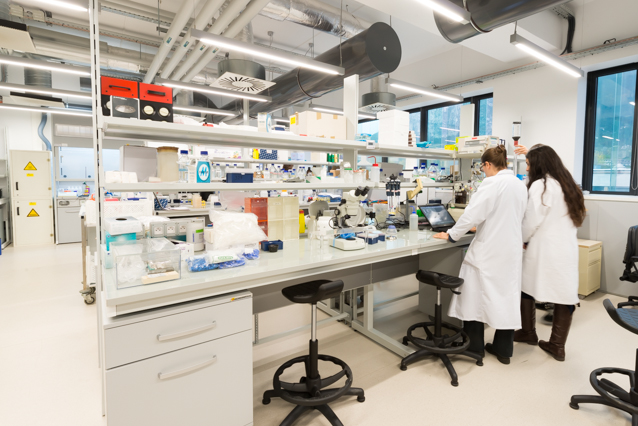Call for students applications. Academic year 2020-2021
In the framework of the Grenoble Graduate School in Chemistry, Biology, and Health (CBH-EUR-GS), the GRAL research programme funds MSc (Master 2) research scholarships. The candidates should be interested in any of the research topics of the labs associated with the GRAL programme at the IRIG institute: IBS, BCI, BGE, CBM, and PCV.
The call is open to EU and non-EU students.
We seek motivated candidates interested in the following Master programmes (2nd year MSc / Master 2 / M2) at Université Grenoble Alpes (taught in English):
Master in biology:
Master in Nanosciences, nanotechnologies:
Master in Physics:
The successful candidates are expected to register to one of the above Master 2 programmes at Université Grenoble Alpes. A GRAL scholarship of 8 000 € is offered to cover the academic year from September 2020 to June 2021, which includes 4 months of courses and 6 months of research internship. A maximum of 7 scholarships are available this year.
Further information can be obtained from GRAL’s Executive Manager: anne-mathilde.thierry@ibs.fr
- Opening of the call for applications: February 2020
- Applications must be submitted by May 24th 2020
- Results: June 2020
Candidates must be accepted and registered in the 2nd year of a dedicated MSc programme (M2) of Université Grenoble Alpes to receive the GRAL scholarship. For more information about registration at Université Grenoble Alpes, check UGA’s website (in French only at the moment). Application deadlines can differ between the different Master programmes.
The candidates must send their application in a unique pdf file to anne-mathilde.thierry@ibs.fr before May 24th 2020 (23:59, CET), including:
- A cover letter indicating the selected MSc programme at Université Grenoble Alpes, and choices 1 and 2 for the 6-month research internship project
- A CV
- Diplomas and copies of academic transcripts equivalent to a 1st year of MSc (or 3-yr BSc and 1 year of MSc), translated to French or English when appropriate
- Level of language proficiency (e.g. TOEIC, Bulats, etc.) if you’re not a native English speaker
- One letter of recommendation
The files will be evaluated by a selection committee composed by the GRAL Directory and the MSc programmes’ administration. The admission to a 2nd year MSc programme (M2) at Université Grenoble Alpes is fully independent of the GRAL Master 2 Research Scholarship.
The scholarship is conditional to the registration to a Master 2 programme at UGA, and to the recipient maintaining a satisfactory academic record in the programme.
Non-EU students must contact the CAMPUS France services of their country.
If you’re a non-EU student residing in Europe, look here.
If you’re a non-EU national enrolling for the first time in a university program in France, log in to the Etudes en France platform. This applies if you are a citizen from: Algeria, Argentina, Benin, Brazil, Burkina Faso, Burundi Cameroon, Chile, China, Colombia, Comoros, the Republic of the Congo, South Korea, Ivory Coast, Egypt, United States, Gabon, Guinea, Haïti, India, Indonesia, Iran, Japan, Kuwait, Lebanon, Madagascar, Mali, Morocco, Mauritius, Mauritania, Mexico, Nigeria, Peru, Senegal, Democratic Republic of Congo, Russia, Senegal, Singapore, Taiwan, Tchad, Togo, Tunisia, Turkey, and Vietnam.
If you’re a non-EU national, not residing in Europe, and not citizen of one of the countries listed above, look here.
List of research internships available for the GRAL Master 2 Research Scholarship.
Academic Year 2020-2021
Up to one Master 2 scholarship per group will be funded by GRAL.
| Lab. | Group | Research project | Supervisor(s) |
| BCI | IMAC | In vitro and in vivo characterisations of five promising biomarkers for the diagnosis and treatment of preeclampsia Description |
Nadia Alfaidy |
| BCI | IMAC | Role of N‐myc Downstream Regulated Gene member 4 (NDRG4) in adrenocortical cancer aggressiveness Description |
Nadia Cherradi |
| BCI | PBRC | Interactions between Pseudomonas aeruginosa toxin ExoU and its eukaryotic partners Description |
Viviana Job |
| BCI | PBRC | Transmembrane pore formation by Pseudomonas aeruginosa toxin ExlA Description |
Antoine Maillard |
| BGE | Gen&Chem | Function of the ESCRT protein CHMP1B in membrane remodelling Description |
Laurence Aubry |
| CBM | AFFOND | Localization and role of Prokineticin receptors 1 and 2 in cerebral vascular endothelial cell Description |
Christel Marquette |
| IBS | CHANNELS | Design of light-gated potassium channels Description |
Michel Vivaudou |
| IBS | DYNAMOP | Design of advanced fluorescent proteins for super-resolution fluorescence microscopy Description |
Dominique Bourgeois |
| IBS | EBEV | Does banana shaped dimeric ALIX influence Chmp4b polymerization and membrane remodelling? Description |
Cécile Boscheron |
| IBS | FDP | Deciphering multivalent interactions in the clathrin-mediated endocytosis pathway Description |
Sigrid Milles |
| IBS | IRPAS | Molecular interplay at the phagocytic synapse Description |
Philippe Frachet |
| IBS | IRPAS | Do C1s mutations identified in diseases affect the function of this immune protease? Description |
Christine Gaboriaud |
| IBS | IRPAS | Characterization of the interaction between new recombinant Immunoglobulins M and the complement Description |
Jean-Baptiste Reiser |
| IBS | MEM | Development of electron diffraction for 3D nano-sized crystals of proteins Description |
Dominique Housset |
| IBS | MEM | Structural characterization of bunyavirus replication complexes by single particle cryo-electron microscopy and tomography Description |
Hélène Malet |
| IBS | MEM | Using atomic force microscopy topography to reconstruct large biological complexes Description |
Jean-Luc Pellequer |
| IBS | METALLO | Structural study of the Nitrogenase active site maturation using CryoElectron Microscopy in anaerobic conditions Description |
Mickaël V. Cherrier |
| IBS | METALLO | Mechanism of radical SAM enzymes involved in the maturation of ribosomally-synthesized and post-translationally modified peptides with antibiotic properties Description |
Yvain Nicolet |
| IBS | MICA | Moving Structural Biology into the Cell Description |
Irina Gutsche |
| IBS | MICA | Visual Proteomics by high resolution cryo-EM of crude cell extracts Description |
Irina Gutsche & Ambroise Desfosses |
| IBS | MP | Engineering production of NADPH oxidase NOX2/p22phox using lentiviral expression system: Towards structural characterization and protein therapy of X-linked chronic granulomatous disease (X-CGD) Description |
Marie José Stasia & Franck Fieschi |
| IBS | PATBAC | Exploring the link between the human microbiome and cancer development Description |
Pauline Macheboeuf |
| IBS | SAGAG | Enzymatic regulation of cell-surface glycanic landscape in human disease Description |
Romain Vivès |
| IBS | VIC | Investigating an epigenetic pathway in a deadly emerging fungal superbug Description |
Carlo Petosa |
| IBS | VIC | Nucleoid organisation and dynamics of the radioresistant bacterium, Deinococcus radiodurans, in response to extreme irradiation Description |
Pierre Vauclare & Joanna Timmins |
| IBS | VRM | Borna disease virus replication: do N, P and X form a ternary complex? Description |
Thibaut Crepin |
| PCV | ChromDev | Impact of epigenome editing on gene expression and cell fate in plants Description |
Christel Carles |
| PCV | Flo_Re | Prediction of gene regulatory network from genome sequence Description |
François Parcy |
| PCV | Flo_Re | In planta characterization of LFY and UFO interactions Description |
Gabrielle Tichtinsky |
| PCV | LPM | Exploring the molecular and structural consequences of UV-B illumination in microalgae using bioimaging techniques Description |
Florence Courtois |
| PCV | StrucDev | Determining the function of SEPALLATA3 oligomers in flower development Description |
Véronique Hugouvieux |
| PCV | StrucDev | Phyllogen-MADS Transcription Factor Interactions and Dynamics Description |
Chloe Zubieta |
Photo © : IBS

